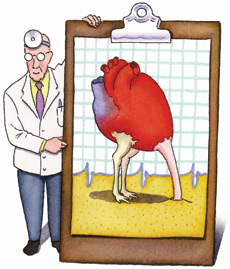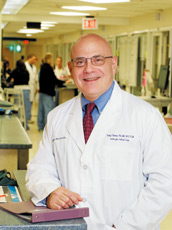Five minutes from now
Concealed in the lines of data parading across bedside monitors are clues of immediate threats to ICU patients
 |
By Sylvia Wrobel
Tuesday, 10 p.m. More than 150 patients are receiving intensive care in one of Emory Healthcare’s critical care units. Teams of critical care professionals—nurses, physicians, respiratory therapists, pharmacists—stand guard. Streams of data flash across the bedside monitors.
Five minutes from right now, one of those patients will require urgent intervention, possibly from an abnormal heart rhythm, a seizure, or a sudden drop in blood pressure. One of the teams will swing into action, working to reverse the process and save a life. But what if the team knew a few minutes in advance that the patient in bed 11 would face a serious life threat? With that information, could the team prevent the problem instead of treat it?
Tim Buchman, founding director of Emory’s Center for Critical Care, expects to do just that.
Buchman, who came to Emory in 2009 and describes himself as a “recovering trauma surgeon,” is taking predictive health to the bedside of Emory’s most vulnerable patients. “Most of predictive medicine is focused on a long time line, typically using genetics to manage risks for chronic illnesses such as heart disease and cancer,” Buchman says. His focus is on ferreting out immediate threats to life—before those threats become obvious.
The clues are in plain sight, says Buchman, concealed in the lines of data parading across the bedside monitors. “We look, but because of the way the data are conventionally displayed, we see patterns as we expect them to be.”
Take regularity. Generations of physicians and nurses were taught that health is fundamentally regular, and that regularity should be encouraged if not enforced. Three square meals. Twenty-eight day menstrual periods. Even the cryptic abbreviations scattered through the medical chart reinforced the thinking: a normal heart exam was coded “RRR,” regular rate and rhythm.
Wrong on all counts, says Buchman. “Feel your own pulse,” he says. “Take a deep breath in and hold it for a few seconds. Then exhale completely and hold it for a few seconds. Feel your pulse slow and speed up? That’s adaptive variability.”
That capacity for moment-to-moment adaptation in response to changing physiologic demand is the true signature of health, says Buchman. The loss of adaptive capacity—increasing regularity in the face of everyday changes in our immediate environment—signals that something is wrong and the patient is at risk for sudden deterioration.
“We challenge patients as part of routine care, with fluids, drugs, and machines like respirators,” Buchman says. “They ought to respond by varying their physiology. When they fail to respond, we need to pay attention.”
Detecting those responses involves more than glancing at the bedside monitors. Those familiar displays, unchanged over four decades, present only a few seconds worth of data before the tracing runs off the end of the screen.
“A few seconds is surely the right time scale to see how patients are responding to treatment of a life-threatening event, but the loss of variability leading up to the event occurs over minutes, or even hours,” he says.
The displays need to be redesigned to present clinicians with new and more meaningful information. Clinicians are reluctant to embrace variability as a vital sign, says Buchman. In fact, many traditional treatments in the ICU, such as ventilators, force regularity onto patients.
 Tim Buchman is founding director of Emory’s Center for Critical Care. |
But Buchman invites a simple experiment. “Find a watch with a sweep second hand, and try to take a breath of the same volume every five seconds. We call this metronomic breathing, because it is in perfect time. After about a minute, you’ll find you can’t keep time.”
While many ICUs force just such regularity into patient physiology, Buchman and his teams favor the opposite. At Emory University Hospital, for example, the most common ventilator mode is ASV or adaptive support ventilation. “We use the most advanced ventilators available. They can vary the size of the breaths and the interval between those breaths while minimizing the work of breathing—just as our natural physiology expects.”
Reconstituting and sustaining that natural variability might be important in other physiologic systems. Ten days into a critical illness, patients have typically lost most of their normal variation in hormone levels such as cortisol, the growth hormone, and prolactin. “We’re not sure if those losses are the result of the critical illness or the treatments. But patients have to recover at least some variability in order to get out of the ICU,” says Buchman.
“Today, we’re studying the waveforms of patients who go on to have a life-threatening event, teasing out the regularity and testing new metrics of variability—seeing how frequently patterns of heart rate and blood pressure repeat themselves—to see whether the repetition has predictive value in other patients.
“We are prototyping new ways of displaying the data that we routinely collect. We have to be able to compare a patient’s current trajectory with her path an hour ago, and moreover to compare both of those with similar patients.
“With the right metrics, and better displays, we might be able to peer a few minutes into the future.” Just far enough to prevent disaster and guide the patient back on course. EM


